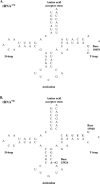Mutational analysis of the mitochondrial tRNA genes and flanking regions in umbilical cord tissue from uninfected infants receiving AZT-based therapies for prophylaxis of HIV-1
- PMID: 19031409
- PMCID: PMC3191876
- DOI: 10.1002/em.20433
Mutational analysis of the mitochondrial tRNA genes and flanking regions in umbilical cord tissue from uninfected infants receiving AZT-based therapies for prophylaxis of HIV-1
Abstract
A sensitive vertical denaturing gradient gel electrophoresis (DGGE) method, using 13 unipolar psoralen-clamped PCR primer pairs, was developed for detecting sequence variants in the 22 tRNA genes and flanking regions (together spanning approximately 21%) of the human mitochondrial genome. A study was conducted to determine (i) if mitochondrial DNA (mtDNA) polymorphisms and/or mutations were detectable in healthy newborns and (ii) if prepartum 3'-azido-2',3'-dideoxythymidine (AZT) based HIV-1 prophylaxis was associated with significant increases in mtDNA mutations and changes in the degree of heteroplasmy of sequence variants in uninfected infants born to HIV-1-infected mothers. DGGE analysis of umbilical cord tissue (where vascular endothelium and smooth muscle cells are the major source of mtDNA) showed that mtDNA sequence variants were significantly elevated by threefold in AZT-treated infants compared with unexposed controls (P < 0.001), with 24 changes observed in 19/52 (37%) treated newborns (averaging 0.46 changes/subject) versus only eight changes found in 7/55 (13%) unexposed newborns (averaging 0.15 changes/subject). Six distinct sequence variants occurring in unexposed controls were predominately synonymous and homoplasmic, representing previously reported polymorphisms. Uninfected infants exposed to a combination of AZT and 2',3'-dideoxy-3'-thiacytidine and "maternal HIV-1" had a significant shift in the spectrum of mutations (P = 0.04) driven by increases in nonsynonymous heteroplasmic sequence variants at polymorphic sites (10 distinct variants) and novel sites (four distinct variants). While the weight of evidence suggests that prepartum AZT-based prophylaxis produces mtDNA mutations, additional research is needed to determine the degree to which fetal responses to maternal HIV-1 infection, in the absence of antiretroviral treatment, contribute to prenatal mtDNA mutagenesis.
Figures


Similar articles
-
Transplacentally exposed human and monkey newborn infants show similar evidence of nucleoside reverse transcriptase inhibitor-induced mitochondrial toxicity.Environ Mol Mutagen. 2007 Apr-May;48(3-4):201-9. doi: 10.1002/em.20201. Environ Mol Mutagen. 2007. PMID: 16538687
-
Plasma and cellular markers of 3'-azido-3'-dideoxythymidine (AZT) metabolism as indicators of DNA damage in cord blood mononuclear cells from infants receiving prepartum NRTIs.Environ Mol Mutagen. 2007 Apr-May;48(3-4):307-21. doi: 10.1002/em.20298. Environ Mol Mutagen. 2007. PMID: 17358024 Clinical Trial.
-
Mitochondrial toxicity in hearts of CD-1 mice following perinatal exposure to AZT, 3TC, or AZT/3TC in combination.Environ Mol Mutagen. 2007 Apr-May;48(3-4):190-200. doi: 10.1002/em.20191. Environ Mol Mutagen. 2007. PMID: 16395692
-
Fetal consequences of maternal antiretroviral nucleoside reverse transcriptase inhibitor use in human and nonhuman primate pregnancy.Curr Opin Pediatr. 2015 Apr;27(2):233-9. doi: 10.1097/MOP.0000000000000193. Curr Opin Pediatr. 2015. PMID: 25635584 Free PMC article. Review.
-
Zidovudine: a review of its use in the management of vertically-acquired pediatric HIV infection.Paediatr Drugs. 2002;4(8):515-53. doi: 10.2165/00128072-200204080-00004. Paediatr Drugs. 2002. PMID: 12126455 Review.
Cited by
-
Zidovudine exposure in HIV-1 infected Tanzanian women increases mitochondrial DNA levels in placenta and umbilical cords.PLoS One. 2012;7(7):e41637. doi: 10.1371/journal.pone.0041637. Epub 2012 Jul 27. PLoS One. 2012. PMID: 22848552 Free PMC article.
-
Cardiac effects of antiretroviral therapy in HIV-negative infants born to HIV-positive mothers: NHLBI CHAART-1 (National Heart, Lung, and Blood Institute Cardiovascular Status of HAART Therapy in HIV-Exposed Infants and Children cohort study).J Am Coll Cardiol. 2011 Jan 4;57(1):76-85. doi: 10.1016/j.jacc.2010.08.620. J Am Coll Cardiol. 2011. PMID: 21185505 Free PMC article.
-
Evidence of Subclinical mtDNA Alterations in HIV-Infected Pregnant Women Receiving Combination Antiretroviral Therapy Compared to HIV-Negative Pregnant Women.PLoS One. 2015 Aug 6;10(8):e0135041. doi: 10.1371/journal.pone.0135041. eCollection 2015. PLoS One. 2015. PMID: 26247211 Free PMC article.
-
Metabolic complications of in utero maternal HIV and antiretroviral exposure in HIV-exposed infants.Pediatr Infect Dis J. 2014 Jul;33(7):734-40. doi: 10.1097/INF.0000000000000224. Pediatr Infect Dis J. 2014. PMID: 24378947 Free PMC article.
-
In utero exposure of female CD-1 mice to AZT and/or 3TC: II. Persistence of functional alterations in cardiac tissue.Cardiovasc Toxicol. 2010 Jun;10(2):87-99. doi: 10.1007/s12012-010-9065-z. Cardiovasc Toxicol. 2010. PMID: 20155331 Free PMC article.
References
-
- Bai R-K, Leal SM, Covarrubias D, Liu A, Wong L-JC. Mitochondrial genetic background modifies breast cancer risk. Cancer Res. 2007;67:4687–4694. - PubMed
-
- Barret B, Tardieu M, Rustin P, Lacroix C, Chabrol B, Desguerre I, Dollfus C, Mayaux MJ, Blanche S. Persistent mitochondrial dysfunction in HIV-1-exposed but uninfected infants: Clinical screening in a large prospective cohort. AIDS. 2003;17:1769–1785. - PubMed
-
- Benhammou V, Tardieu M, Warszawski J, Rustin P, Blanche S. Clinical mitochondrial dysfunction in uninfected children born to HIV-infected mothers following perinatal exposure to nucleoside analogues. Environ Mol Mutagen. 2007;48:173–179. - PubMed
-
- Bialkowska A, Bialkowski K, Gerschenson M, Diwan BA, Jones AB, Olivero OA, Poirier MC, Anderson LM, Kasprzak KS, Sipowicz MA. Oxidative DNA damage in fetal tissues after transplacental exposure to 3′-azido-3′-deoxythymidine (AZT). Carcinogenesis. 2000;21:1059–1062. - PubMed
Publication types
MeSH terms
Substances
Grants and funding
LinkOut - more resources
Full Text Sources
Medical

